| Lesley Roessing reminded me that Feb. 9 was Stop Bullying Day. With a bit more research I also found out that Feb. 22 is Anti-Bullying Day in Canada. Lesley is one of the most prolific readers I know. It was great to finally meet her in person at NCTE last November. She has written for the blog several times before. You can find her previous entries here, here, here, here, here, and here. In addition, she provided the Weekend picks for May of 2018. If you don't have a ready list of books about bullying, you should bookmark this post. It will serve you and your students well. In fact, if you need a list of books about any topic it is time you had a conversation with Lesley. |
Books to Build Conversations about Bullying Lesley Roessing
In 2014, the Centers for Disease Control and Department of Education defined bullying as unwanted, aggressive behavior that involves a real or perceived power imbalance and is repeated or has a high likelihood of repetition. According to stopbullying.gov, a federal government website managed by the U.S. Department of Health and Human Services, there are two modes of bullying: direct and indirect (spreading rumors), and there are four types of bullying: physical, verbal, relational, and damage to property. The newest type of bullying is electronic bullying or cyberbullying, which involves primarily verbal aggression and relational aggression.
According to the National Center for Education Statistics and Bureau of Justice Statistics, 28% of U.S. students in grades 6–12 experienced bullying. In surveys, 30% of young people admit to bullying others. In one large study, about 49% of children in grades 4–12 reported being bullied by other students at school at least once during the previous month, whereas 30.8% reported bullying others during that time.
Adolescent suicide is now the second leading cause of death of young people of age
10-24 (“10 Leading Causes of Death by Age Group, United States–2016,“ National Vital
Statistics System, National Center for Health Statistics, CDC). The CDC cites studies
that have shown that youth who report frequently bullying others and youth who report
being frequently bullied are at increased risk for suicide-related behavior. Youth who
report both bullying others and being bullied have the highest risk for suicide-related
behavior of any groups that report involvement in bullying. While bullying may not be the
sole cause of suicide, the bottom-line of current research findings is that being involved
in bullying in any way—as a person who bullies, a person who is bullied, or a person
who both bullies and is bullied is one of several important risk factors that appears to
increase the risk of suicide among youth.
It is imperative that teachers and especially students discuss bullying in schools, particularly in the middle grades where research shows that the most bullying takes place, and especially because many bullies and victims of bullying do not even recognize that bullying is occurring. “What the Olweus survey identifies as the top three types of bullying—verbal abuse, exclusion, and spreading rumors—kids can see as normal and essentially harmless behavior” When bystanders recognize bullying and intervene, bullying stops within 10 seconds 57% of the time.
These conversations occur more effectively though the reading of novels and memoirs. It is crucial that adolescents experience bullying and the effects of bullying, not in real life, but through novels such as the 36 novels presented below. Students are more inclined to talk about how characters handled or mishandled situations than to analyze their own actions or those of their peers. Novels such as these can generate important conversations that adolescents need to have and share truths that they need to see; these stories provide not only a mirror to those who are similar to them but windows into those they may see as different from them, and, even more significantly, present maps to guide adolescents in ways to work through conflicts and challenges and maps to show them where they may become lost. Novels can help readers gain knowledge of themselves and empathy for others.
Any of the novels described in this blog would be a good choice for a whole-class read or, even more effectively, included with 4-5 other novels that address bullying for students to read and discuss in book clubs, comparing issues raised with books being read by all the book clubs.
February 9 National Stop Bullying Day encourages everyone to make an effort to eradicate bullying in their environment. This blog re-introduces the novels highlighted on December 4, 2017 in “Books to Begin Conversations about Bullying” and August 8, 2018 in “Books to Begin Conversations about Bullying--Part 2,” as well as including novels I have read and reviewed since the time of those blogs.
1. Thompson, Holly. Orchards. Delacorte Books for Young Readers, 2011.
| In addition to the statistics above, a study in Britain found that at least half of suicides among young people are related to bullying and that 10 to 14 year old girls may be at even higher risk for suicide. As the social hierarchy intensifies in middle school, girls form cliques and can get meaner. PBS Parenting explains that much of this behavior stems from the intense desire to belong, the need to feel powerful, and the conditioning that many girls have to not express their feelings directly. Some girls function as leaders, others as followers, and the rest live outside the groups. In this powerful verse novel, Kana Goldberg, an American middle school girl, feels guilty when Ruth, a classmate, commits suicide: |
should I have sat across from you at lunch in the cafeteria?
should I have invited you to be in my group in science
or my critique partner in art?
Kana reflects on the social hierarchy in her eighth grade class:
electrons
arranged in shells
around Lisa
Becca and Mona
first shell solid
the rest of us
in orbitals farther out
less bound
less stable
and you
in the least stable
most vulnerable
outermost shell.
Kana was not only a bystander. She acknowledges that Lisa was mean to Ruth and
we all
followed
her lead.
what I wanted to know was
if depression is so common
is depressions was a possibility
for someone like you, Ruth
then why didn’t they teach us about it?
Kana finally realizes that the list of what they didn’t do--
end the texting
talk with you
laugh with you
listen to you
include you
…seems so basic and short.
There is another tragedy associated with the bullying and, through the rituals surrounding death Kana practices with her relatives and the Japanese community, she returns home with ideas of ways to create a memorial to the friends who were tragically affected by the bullying—and to help, not just the girls but the entire 8th grade class, to “go on.”
Weeks, Sarah and Varadarajan, Gita. Save Me a Seat. Scholastic Press, 2016
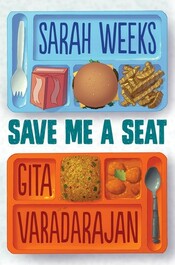
Joe, a student with APD or Auditory Processing Disorder, is bullied by his fellow fifth graders, especially Dillon Samreen. When Ravi moves from India to America, he assumes that the other fifth graders will be impressed by his intelligence and athleticism, but all they notice is his accent and other ways he is different. Ravi assumes that Dillion, being Indian-American, will be his friend but finds himself also the target of his bullying and his classmates’ laughter.
There are many novels that focus on bullying, but what I found most important about Save Me a Seat is that Ravi does not realize that in his school in India where he is was one of the popular crowd, if he was not actually a bully himself, he was unkind to other students and stood by, laughing, when students were bullied by others.
In the novel when Ravi finally sees that "There is more to [Joe] than meets the eye" and that he is the victim of bullying; he comes to the conclusion, “I don’t need to show off anymore. I’m not like Dillon Samreen and I never will be,” and he stands up for Joe
The characters in Save Me a Seat are fifth graders. According to research, most bullying occurs in grades 6-8. Perhaps if enough students read and discuss this novel in fifth grade, those statistics will change.
3. Cerra, Kerry O’Malley. Just a Drop of Water. Sky Pony Press, 2014.

But then the events of September 11, 2001, occurred, and Martians did invade the earth, only they looked like Sam and his family—Muslim. Because one of the terrorists had lived in their neighborhood and was a client at the bank where Mr. Madina worked, Sam’s father comes under FBI surveillance, and the neighborhood divides in their support. Not Jake, though. He believes in his friend and his friend’s family, physically fighting the school bully who refers to Sam as a “towelhead” and standing up to his father who apologizes to the bully’s father, an adult bully himself, and to his mother who refuses to support the Madinas, longtime friends and neighbors.
What I appreciated about Just a Drop of Water is that is illustrates another way 9/11 has affected people, especially those Muslim adolescents who populate American schools everywhere. I strongly feel that students should not only be learning about the events and effects of 9/11, but that readers learn more about how events affect people and especially children their ages and have caused many Muslim children, and adults, to become the target of bullying. Other novels—Nora Raleigh Baskin’s Nine: Ten: A September 21 Story, Jewell Parker Rhodes’ Towers Falling, and Wendy Mills’ All We Have Left—also present Muslim characters affected by the events of September 11, 2001
4. Wilhelm, Doug. The Revealers. Square Fish, 2011.
| The Revealers presents bullying as the entire focus of the novel—not just a side issue. The story emphasizes the efficacy of cooperative action when three students who are bullied collaborate on facing bullying with nonviolent action, scientifically studying why students bully. They publish their experiences, and others begin sharing their stories as victims and bullies to be posted on school-wide media. The book highlights creative solutions to problems, using the scientific method, and the three students’ research—in cooperation with many members of the student body, including the school’s most feared bully—becomes a science fair exhibit which brings the problem to the notice of the principal and a school board member. The novel highlights the problem of administrative denial and even acceptance, which, unfortunately, is too realistic. |
5. Harmon, Mike. Stick. Knopf Books for Young Readers, 2015.
| Patterson ("Stick") is a football player, but with the overwhelming pressure from his father and his coach, he has lost the love of playing. Preston is an individual who has no friends but lives life on his own terms as he struggles with the guilt and trauma of his father's death; to compensate, he dresses as a superhero and, in disguise, he helps others in need. When the two teens become friends, Preston encourages Stick to decide if he wants to remain on the team. His decision to quit appears to derail his life when his father kicks him out of the house and his former friends on the team savagely bully not only him but also Preston. Taking charge of his life actually helps Patterson get back on track, a track that follows his heart and helps him save his father. The relationship between Stick and Preston shows the importance of standing up for others and how that action can lead to standing up for oneself. |
6. Magoon, Kekla. Camo Girl. Aladdin, 2011.
| Camo Girl is an important story, written for readers in Grades 5 and up. Ella and Z are sixth-grade outcasts, and they are best friends. But they are not best friends because they are outcasts; they are there to support each other against bullies—no questions asked, no matter how weirdly Z acts and how Ella looks. When a new student befriends Ella, she thinks she may have to choose between popularity and her friendship with Z, but just maybe the popular Bailey, who has his own view of reality, can help both of them. This novel provides a good read for young adolescents, both boys and girls, who just want to be accepted by their peers. |
7. Holt, K.A. Rhyme Schemer. Chronicle Books, 2014.
| Seventh-grader Kevin, main character of this hilarious verse novel, is bullied by his older brother. In turn, he bullies kids at school. When he gets in trouble, he can no longer be caught bullying, and, as a result, two things occur: his former victims begin bullying him and he finds a secret way to bully others—through black-out poetry. The school librarian shows him that he actually has a talent, Kevin realizes he can be important though his poetry, rather than through his reputation as a bully. |
8. Erskine, Kathryn. Quaking. Philomel, 2007
| Quaking hits one of the most important topics in adolescent life—bullying—from all sides. Bullies are not only teenage boys (although there is one of those in this novel) and their followers but can be teachers, parents, and adults who bully each other, misusing their power over others. And bullies are bullies for a variety of reasons. This novel can serve as a map, illustrating ways to deal with bullies. The reader cares about eighth grader Matt—possibly more than she does about herself—and her new family, Quakers, who helps her value herself and find her voice. |
9. Sonnenblick, Jordan. The Secret Sheriff of Sixth Grade. Scholastic Press, 2017.
| Much bullying begins in sixth grade. The Secret Sheriff of Sixth Grade provides important topics for middle grade students to read and discuss—bullying and abuse—told with engaging, addictive humor. Reluctant readers will cheer for Maverick, a young hero readers will love. |
10. Gregorio, I.W. None of the Above. Balzer + Bray, 2015.
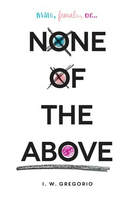
When the entire school finds out and there are incidents of cyberbullying as well as shaming and an attack in a club, Kristin discovers the importance of a support group of those who can identify with, and understand what, she is facing, as well as friends who still accept and maybe even love her for who she is. The novel will lead to important provocative conversations and, because of the clinical details, sex, and profanity, it is a novel best suited for mature readers.
11. Deloza. Lara. Winning. HarperTeen, 2016.
| Another type of bullying is manipulation. Alexandra Miles’ main ambition, actually obsession, of the year is to be crowned Homecoming Queen—a step on her way to Miss America. Alexandra carefully orchestrates every step, every word, every emotion—hers and those of others around her. She is mean, but not the typical mean girl; she is an actual frenemy—friend of enemy, depending on what it gets her. And Alexandra always has a plan. Many chapters are narrated by Alexandra; others are narrated by her victims and accomplices or victims who become accomplices and vice versa. At the end, others stooping to her level but no one is hurt, and the ending could generate classroom or book club discussions on how to beat bullies at their own game without becoming them. |
12. Rawl, Paige and Benjamin, Ali. Positive: A Memoir
| Positive relates a true story, the story of Paige Rawl who was born HIV positive. In sixth grade she shares her secret with her best friend who tells all their friends. Paige is then bullied by her classmates, and her coaches, her counselor, and administrators refuse to intervene, resulting in a suicide attempt. Positive is actually a story about surviving bullying rather than surviving illness and having the courage to face the world and share her journey. |
13. Dean, Carolee. Forget Me Not. Simon Pulse, 2012.
| Shaming is defined as the act of publicly criticizing and drawing attention to someone and, therefore, is a form of bullying. One of the more interesting novels is the multi-genre Forget Me Not in which the author creatively employs a variety of poetic forms (and script writing) to identify the characters and alter the mood of the plot so subtly as to not disrupt the reading and the reader. The storyline, will provoke important conversations among teens about cyberbullying, shaming, and suicide. In response to a compromising photo of her that is texted and causes all her schoolmates to shame her, Ally commits suicide —or so she thinks—as her only way out. A friend tries to save her by showing her that her life has value and that she can make the decision to live. |
14. Blount, Patty. Some Boys. Sourcebooks Fire, 2014.
| This unforgettable novel features an adolescent who has been raped and shamed but stands up for herself, even again the rapist’s best friend. In this provocative novel Grace and Ian narrate alternating chapters, and when Ian questions the way she dresses, Grace asks why her clothing choices should matter or be assumed to send a message. |
15. Summers, Courtney. All the Rage. St. Martin's Griffin, 2015.
| In All the Rage Romy has been assaulted by the sheriff’s son. No one believes her allegations and, by coming forward, she is bullied by her former friends. As other girls become hurt, Romy has to decide how hard she will fight to be believed. |
16. Thompson, Holly. Falling into the Dragon’s Mouth. Henry Holt and Co., 2016
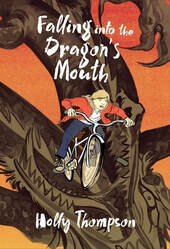
Jason Parker is a fifth grade American boy living and attending school in Japan where he is different—and bullied for being different. He has redefined “friend” as anyone who doesn’t punch or kick him or refer to him as a “stinking foreigner.” Near the end of the school year Jason is placed in a group, or han, with five of the meanest kids in the class. What follows is relentless bullying, and the reader sees the importance of telling an adult, but not just any adult. The teacher has to be aware of what is going on, and Jason is afraid that his parents will make it worse. He is hoping to last until his parents can afford to send him to the international school.
With the support of his little sister, two new friends outside school—an older man with Parkinson’s disease and a teen who quit school because of the bullying, his English group, and aikido, Jason perseveres until the bullies “play” the choking game and Jason’s parents and the school finally become involved. Jason’s aikido instructor explains “…we need to train so that we sense danger in order to avoid it” but also warns him “the world is full of all kinds of people and some of them are a bit lost” (308-309).
In short lyrical free-verse lines, the reader learns about Japanese culture but also the trials of being perceived as different in any culture. The reader experiences the effects of bullying on children and the importance of effectively stopping and preventing bullying but also becomes aware of the dilemmas involved with trying to end bullying. I found myself frustrated that Jason did not tell his parents, but then I am an adult. I also was disturbed that his teacher ignored all the signs, but I have learned that this is too often true. In fact, Jason wants to change the rule that allows teachers to hit students.
An effective student examination of bullying would be for a class to read both Orchards and Falling into the Dragon’s Mouth to gain different perspectives and begin conversations on the different types of bullying, or for half a class to read each one or to combine these novels with other books on bullying that I reviewed in “Books to Begin.
17. Korman, Gordon. Restart. Scholastic Press, 2017.

After a particularly vicious prank, pulled with his best friends, fellow football team members Aaron and Bear, he was given community service as a punishment (which is how he became involved with the senior citizens he now helps voluntarily). Surprisingly his father approves of Bully Chase and is disappointed that his concussion prevents him from playing football.
As Chase navigates his “new” world, he is worried that he might slip back into old habits and that he won’t be able to convince his new friends and his step-family that he really has changed. He finds that he might still have to pay for who he was and figure out who he will be able to become. I read this well-written novel straight through, worrying that it might be too late for Chase to be accepted for who he now is.
18. Squint. Morris, Chad and Shelly Brown. Shadow Mountain, 2018.

“So hit me with your best challenge for spreading kindness…. A challenge that helps people relate to people…. Share a little piece of yourself, like I did, and let us get to know and love you.” (238) These final words from Danny, a boy who suffered and died from progeria, guide Flint and McKell in their search for acceptance and belief in themselves.
Flint, nicknamed Squint because he has an eye disease that compromises his eyesight, has two goals: to win a comic book contest and make friends in middle school. McKell is a new student from a school where she had few friends. In Flint’s school she hangs out with the popular kids who bully Squint. But McKell befriends Squint, and they encourage each other, following her brother’s Danny’s video challenges, to attempt something new and follow their passions. When Squint adds a female superhero hero, Diamond, to aid his comic hero also named Squint, he supports McKell in overcoming her fear of sharing her talent. As they step out of their comfort zones, Squint confronts his bullies and finds that relationships are not always what you think they are.
This is a powerful novel about trust in others and trust in oneself and about adolescents learning to be themselves as they navigate middle school with all its rules. I was hoping for some comics (graphics) to go along with the story, but the Squint does share the text of his comic book as he creates it.
19. Haston, Meg. How to Rock Braces and Glasses. Poppy, 2013.

Kacey is a bully. She does not see herself s a bully or even as a mean girl; she sees herself as honest, as knowing what everyone should say, do, and wear, and she is just there to help them or help them get real. "The truth may hurt, but it's always better to know"(189). Her world as school leader falls apart when an eye infection leaves her with glasses and new braces leave her—a school news reporter and star of the musical—with a lisp. Her best friends drop her and cyber bully her and while an old friend offers to help, it is to receive help herself, having decided in fifth grade that she was embarrassed to be seen with Kacey (which is not how Kacey remembers the end of the friendship). And the cute nerd seems to be dating her former best friend. Kacey reclaims her popularity, but takes responsibility for herself and her past actions.
20. Baskin, Nora Raleigh. Runt. Simon Schuster Books for Young Readers. 2013.

As the students in this novel’s middle school bully each other, are aghast or sometimes proud of their attempts, become bullies and are bullied, they each deal with bullies and the effects of bullying. Elizabeth ruminates on the effect of her unintended bullying of a scared little dog who now shakes at her approach, “There are some kids of hurt that are just too much to feel.” (95) But middle school bullying as outlined above takes many forms; in general boys are more physical and girls employ relationship bullying, exclusion. In both genders, bullies seek out the weak. “In the wild mountain lions have been known to attack their own leader when he appears weak and unable to protect his pride.” (171) Apparently no one is safe.
As the dog who narrates the Afterword says, “I want to know where I belong.” (194). These characters and their stories will help generate discussions that may help readers clarify not only where they belong but where they want to belong, how they want to be treated and how they want to treat others.
21. Kelly, Erin Entrada. Hello, Universe. Greenwillow Books, 2017.
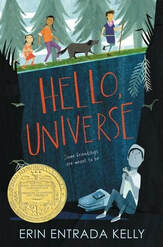
Three young adolescents find each other and, even though “there are no coincidences,” they bond through a series of happenstances. Virgil is trapped and his life is endangered when Chet Bullens, the school bully, throws Virgil’s pet guinea pig down an abandoned well in the woods and Virgil follows to save him. Searching for him with new friend Kaori, and the assistance of little sister Gen, Valencia finds Virgil and the friendship they both desperately want and need. Through these connections, Virgil gains the strength to stand up to the bully and demand his place in a family who is quite different from him.
22. Connor, Leslie. The Truth as Told by Mason Buttle. Katherine Tegen Books, 2018.
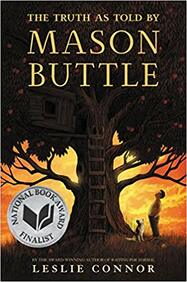
Mason has suffered more than his share of losses—he had a walkaway daddy, his grandfather and mother died, and, along with most of the town, Mason is still mourning his very best friend who fell from the ladder of their tree house and died. And there are two bullies who are always after him.
What Mason does have, beside an indomitable spirit, are a compassionate school social worker, a new best friend who is as loyal as Mason, a neighbor’s dog who loves him, and a supportive family. However, what Mason doesn’t realize is that Benny died under mysterious circumstances and some people, including the lieutenant who questions him incessantly and Benny’s two fathers, think Mason may be to blame. As Calvin and Mason create their own hideaway and battle bullies, Mason inadvertently solves the crime, but he still is never one to think badly of anyone, “My heart feels scrambled” (p. 320). The truth as told by Mason Buttle is the truth.
The reader will fall in love with Mason, and even though he may begin the story wearing a T-shirt that proclaims him as “STOOPID,” he ends with the revelation that “Knowing what you love is smart.”
With very short chapters and a wealth of diverse characters, this novel would be a good teacher read-aloud.
23. Buyea, Rob. The Perfect Score. Delacourte Press, 2017.

With the help of their two teachers who have their own personal problems, these classmates band together as The Recruits and face off against the biggest bully of all, the standardized test.
Each chapter is narrated by one of these students, demonstrating perspective but also providing an opportunity for a Reader's Theater read aloud of the novel. Or students could read this book in lit circles, each lit circle tracking one of the students.
24. McAnulty, Stacy. The Miscalculations of Lightning Girl. Random House,
2018.

But Nana has other plans, and she enrolls Lucy in 7th grade at the local middle school for one year. There Lucy hides her identity as a “freak” and makes two friends, but when her secret is revealed, she finds out that middle school is where many feel different and anxious, even the popular kids.
Reading this wonderful new book for grade 4-8 readers straight through, I fell in love with Lucy and empathized with her struggles to understand human behavior—the mean girls who bully her, making fun of her differences and excluding her; the boy who cheats off her in math class and is constantly taking photographs; the BFF who betrays her. When she works on a school project and falls in love with a dog at the shelter, she learns to reach out to save him and finds there are people she can depend on, especially Levy, the cheater. Levy grew into my favorite behavior because, an outsider himself, he understood human behavior and was able to capture, appreciate, and share the complexity through his photography.
Middle school is where very few fit in—whether a genius or not.
25. Friend, Natasha. How We Roll. Farrar, Straus and Giroux, 2018.

Quinn has a brother who is on the autism spectrum, and his tantrums and food requirements consume her parents’ attention, especially her mother’s. So when Quinn’s hair falls out and she is diagnosed with alopecia, an autoimmune disorder, she handles the challenges on her own, assuming that her middle school friends will support her. Which they do—until they don’t. Bullied and ridiculed by her peers and ignored by her two lifelong friends, Quinn copes by keeping to herself and putting her energy into skateboarding and basketball.
Serendipitously, when the family moves across the country so her brother can attend a special school, she has a chance to start over, with her two new wigs—Guinevere and Sasha. At her new school she meets a group of girls who adopt her. She also meets Jake. Jake, the former star football player, was in an accident and is now a bilateral amputee, sad and bitter, and the two become unlikely friends. Quinn also finds out that it is possible to have friends who like you for who you are, not what you look like.
What impressed me was how three-dimensional the characters were and not only how supportive Quinn is despite her heartbreak, but she is learning to trust that others can be as supportive. I really came to like all the characters, even Jake’s flawed brother and the ninth-grade popular girls (except for the old schoolmates whom the reader was not supposed to like). Readers will experience just how demanding life with a neuro-diverse child can be but, on the other hand, just how supportive a family and a community can be. This is a community I didn’t want to leave.
26. Magoon, Kekla. The Season of Styx Malone. Wendy Lamb Books, 2018.

Ten-year-old narrator Caleb Fanklin and his eleven year old brother Booby Gene live in a small town and their father does not allow them to venture out from where everyone knows them and they are “safe.” Caleb’s goal is to get to the museum in Indy. And to be extraordinary, not “extra-ordinary” as he thinks his father is calling him.
Then the brothers meet a mysterious sixteen-year-old name Styx Malone, Yes, as in Greek mythology, where the River Styx separated the world of the living from the world of the dead. Malone may not be their transport from the dead to the living but it sure seems so. Styx is free from parental restraints and always has a plan that becomes bigger and better. “The moment felt like Saturday, like summer heat, like adventure…. It felt like the soft swish of corn tassels and being one step closer to an impossible dream…’One step closer to our happy ending.’” (116)
As the boys become more and more involved with him, providing the friendship it appears he is missing in his life, they learn that he is a foster child who has moved from home to home, family to family, and his life may not be as glamorous as it seems. “’Only person you can ever count on is yourself.’…There were lots of people I could count on…. But I got what Styx was saying: Freedom came with a price.” (154)
Many things changed the season Styx Malone “shook [their] world.” That summer did make a difference—to Styx himself and to expanding the world of the Franklins.
There were many interesting, delightful characters, including Cory Cromier, the eleven-year-old bully who loves babies and becomes a Franklin brothers’ ally, and Pixie, Styx’s magical ten-year-old foster sister. This book, with its short chapters, each ending with seductive llnes. and prospective discussions of morality, ethics, responsibility, friendship, and family, would make a good read aloud for grades 5-8.
27. Abbott, Tony. Firegirl, Little, Brown Books for Young Readers, 2006.
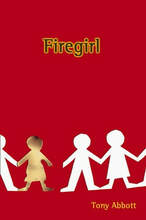
Seventh grader Tom, who, as his mother says needs to “get out there,” has a fairly predictable life. He goes to a Catholic school where he is quiet and most kids ignore him; he has fantasies about saving the life of a grateful Courtney, the prettiest girl in the class; and he hangs out daily with Jeff, a friend who is a little strange, has an unhappy home life, and may not be very truthful or nice but just might help Tom impress Courtney.
Then Tom’s world and values change when Jessica Feeney, a girl who has been badly burned in an accident, joins their class. While many of their classmates ignore Jessica or spread rumors about her, Tom begins seeing her as the person she is even though he is “afraid” of her “The way you look…it scares me.” (134) They strike up somewhat of a friendship although, as Tom admits, “I never talk to you where anybody can see me—” (135), but hard is it is for him, he wants to do what is right, although it is realistically a slow transition. “It suddenly seemed like the hardest thing in the world to go over there. ‘Sure. Okay.”’ (129)
The story shows the how one seventh grader decides the person he will become. As Tom says, “On the outside it doesn’t look like very much happened” (144) and he is not sure that this experience has made him a better person, but he is a changed person and “I’d want to tell her thank you.” (145).
Firegirl is a novel I missed reading when published in 2006,, but when I saw that Tony Abbott has written a new novel, The Great Jeff, that focuses on the bully from Firegirl, I decided to read the earlier novel and am so glad I did. Tom’s voice took me in from the first page and led me through a pivotal three weeks in his adolescent life.
28. Abbott, Tony. The Great Jeff. Little, Brown Books for Young Readers, 2019.

In this well-written, engaging novel, the reader learns more abut Jeff and his family and home life, and he becomes a more sympathetic character. Jeff was nine when his father left. Dad is now living with a second girlfriend who is pregnant and has stopped paying for his education at St. Catherine’s; as a result Jeff has to change schools for eighth grade. “I still wanted to love my dad. Inside me, I still wanted to.” (65)
His mother, an alcoholic, loses her job with no savings for rent. Jeff becomes the sensible one and gives up buying his beloved comics, skips lunch every other day. They begin selling their clothing, household items, and furniture until they lose their rented house and become homeless, moving from run-down motel to a friend’s home to sleeping in their car to a shelter. “Home. Homeless. Funny how it doesn’t take much to go from one to the other.” (171)
Through it all, Jeff stays positive and becomes resilient for his mom who only infrequently behaves like a responsible adult. “She’d taken over sounding grownup now. She had to sometime.” (158) He helps her hide their situation, despite his lack of clothing and the days he smells.
In the shelter Jeff can finally open up and share his problems with other children. “[Jano’s] story was different from mine but the same too.” (199) And when his mother ends up in the hospital, Jeff learns to trust those who were always his friends.
29. Shovan, Laura. Takedown, Wendy Lamb Books/Random House Children's Books, 2018.

Lev’s best friend Bryan knows they won’t spend much time together during wrestling season and starts pursuing other interests. But Lev comes from a sports family where they spend their weekends and holidays at matches and his sister’s field hockey games. However, he finds he is writing poetry to calm himself down and getting headaches and missing the old family dinners and cultural traditions, and now he is even questioning the sport he used to love.
When Lev and Mickey are paired at practice, he is afraid she might get in the way of his training for States. But as their friendship grows, he finds that as he stands up against a wrestler who he has identified as a bully and is keeping Mickey from achieving her goals as a wrestler and this opponent’s father, who is a bullying coach, his own goals just might have changed.
As an author on a sports fiction panel once said, sports is the setting, not the story. And even though the reader learns quite a lot about wrestling and the world of adolescent wrestlers through alternating narratives by Mikayla and Lev, Laura Shovan's new novel is a story about family, friendships, resilience, finding identity, and discovering true motives.
30. Lenz, Niki, Bernice Buttman, Model Citizen. Random House, 2019.

Bernice lives in the Lone Star Trailer Park where she sleeps on the sofa and her brothers share one bedroom; she has a mother who takes Bernice’s lunch money to have herself tattooed. But Bernice has a dream—to raise enough money by any means possible so she can go to Hollywood Hills Stunt Camp and become a famous stuntwoman.
When her mother and boyfriend leave home with their own plans for stardom, Bernice is sent to the picture-perfect town of Halfway to live with her Aunt Josephine, a nun. And as Ms. Knightley advises, “Bernice, I know you may not believe what I’m about to say, but this might be the best thing that’s ever happened to you…Going to a new place is like starting over. It’s like a clean slate.” (41)
As she settles in to her new town with the support of her aunt, Sister Marie Francis who teaches her to ride a horse, and Sister Angela-Clarence who only speaks in children’s book quotes (which actually make more sense than the two other Sisters give credit), Bernice decides that “things could be different in Halfway. I could be different.” (53). Unfortunately, her first day at school she unwittingly makes an enemy of the mayor’s daughter. But she also makes her first real friend.
New Bernice and Old Bernice battle each other as she learns what being a “model citizen” entails. She also learns that, even though her family doesn’t appear to change, her goals might change as she becomes, according to Ms. Knightley observation on a visit to Halfway, “different.”
What I loved most about the novel was the writing. Author Niki Lenz, Children's Author captures Bernice’s voice, while I may not have laughed out loud, I giggled inside through the book, not wanting to stop reading, but not wanting to finish. This book would be a great read-aloud, using passages as a mentor text for Voice.
31. Nesbet, Anne. The Orphan Band of Springdale. Candlewick Press, 2918.

In the midst of all this comes fifth-grader Augusta Neubronner, who as the child of a German-born labor organizer has had to move many times and live on ethics rather than money. As Gusta’s father flees the country and her mother tries to make ends meet, Gusta is sent to her grandmother’s orphanage in Maine taking her beloved French horn, a family treasure which she loves with all her heart but is willing to sacrifice for her new family.
Living with her extended family and the orphans and fighting for their rights (and her father’s reputation), Gusta becomes stronger and more confident. There are many family problems and secrets, so she searches for her great-grandfather’s Wish that her mother told her about, “because her papa had taught her that whatever you can do to put things right in the world, you really must do” (295). But the more she finds out about the people around her, her more her wishes add up until she realizes she can’t name the one wish that would solve everything. And as her mother says, “Wishes are such sneaky things. You can never tell how they’re going to go, wishes.” (429)
This is a book about the importance of truth although sometimes a lie is necessary. And for a truthful person to tell a necessary lie “must take something a lot like love.” (406). It is a story of family and other relationships and acceptance and coming home. Based on the author's mother's family stories, it is a story that rings true.
32. Perkins, Mitali. Forward Me Back to You. Farrar, Straus and Giroux, 2019.
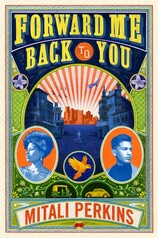
Robin was born in Kolkata, abandoned by his mother, and adopted by loving, wealthy, supportive American parents at age 3, but he has never stopped thinking about his first mother and his life seems to have no direction.
When Kat is sent to Boston to be homeschooled by a family friend’s aunt, Grandma Vee, she becomes a part of a teen church group. When Pastor Gregory takes Robin, Katina, and Gracie to Kolkata to work with female human trafficking survivors, with the help of her new support system and some of the young survivors themselves, Katina learns to trust again; Robin, now Ravi, finds purpose in his life; and Gracie, who was the major support system for both of them, finally gets Ravi to realize his love for her. Kat and Ravi come from the experience having found ways to help these girls and future victims.
Told through very short chapters that alternate between Kat and Robin and simply written, Mitali Bose Perkins' new novel is a valuable read that is accessible to, and appropriate for, all adolescent readers searching for clues to identity and standing up for that identity.
33. Hunt, Lynda Mullaly. Shouting at the Rain. Nancy Paulsen Books, 2019.

Delsie lives on Cape Cod, summer home to tourists, where Grammy cleans guest cottages and they live in a tiny community of four houses where everyone is each other’s family and support system. Papa Joseph has died, and they all miss him and try to fill his space.
The summer before seventh grade is a rollercoaster for Delsie. Her summer best friend, Brandy, is changing; she worrying about getting messy and then befriends the new girl Tressa, a classic Mean Girl. Together they become bullies of exclusion—excluding Delsie.
Luckily, Ronan moves in with his father, and he stands up to the Mean Girls on Delsie’s behalf, and he and Delsie become friends, sharing feelings of abandonment by their mothers and, therefore, being broken. At first Delsie feels like she has to lie to become friends with the girls (“I remember pretending to know things and like things I didn’t just because I wanted them to like me.”), but with Ronan, “I don’t have to lie about who I am.” (99) As family friend Esme tells Delsie, “…anything that matters in this whole…wide…world is about connection.” (83) What begins as a summer of abandonments becomes a summer of connections.
At the end of the summer, Delsie realizes two things: that people, such as the sour Olive, may have their own problems but also may be more caring then others realize or expect (“…instead of just a plain scoop of cold ice cream, a scoop with some chocolate chips hidden inside.”) (180) and that “Knowing that I have real friends that have my back and will protect my feelings—people like Aimee, Michael, and Ronan—makes all the difference.” (240) This pivotal summer Delsie learns a lot about her neighbors, about family, and about support and love.
Reading the novel was also a rollercoaster for me. I was sad about Delsie’s history, mad at how she was being treated by Brandy and Tressa, and glad that she was able to recognize her true friends and revise her definition of family. I know that middle-graders reading this book will identify with some parts of Delsie’s and Ronan’s lives and maybe those who don’t, will see themselves in Brandy or Tressa and gain some empathy and understanding.
34. Warner, Sally. EllRay Jakes the Dragon Slayer. Viking Books for Young Readers, 2013.

Meanwhile EllRay has his own problems with a boy in his class, who while not technically bullying him, continually belittles him in school. When EllRay hits the boy with the ball during a dodgeball game—maybe on purpose—and breaks his glasses, Stanley’s father accuses EllRay of being a bully. Meeting with Stanley and his father, EllRay observes the father’s behavior and discovers why Stanley may act the way he does.
A cute, easy-to-read chapter book that could lead to conversations about bullying, even at a variety of levels.
35. Warner, Sally. Absolutely Alfie and the Worst Best Sleepover. Puffin Books, 2018.

Despite a school rule prohibiting discussing parties where the whole class is not invited,
second-grader Lulu announces to the girls in her class that she is having the “Best” sleepover, like the big girls, but she can only invite 5 girls. She immediately becomes the most popular girl in the class as the other girls compete to be invited. She also becomes demanding—and mean, causing one little girl to cry.
Alfie was Lulu’s best friend in first grade but this year “the thirteen girls in Alfie’s class had kind of shape-shifted roughly into groups of three” (7), and she was not in Lulu’s triad. However, she has her own friends and is welcoming to new students. Now Alfie worries she won’t be invited to the sleepover but she worries more about what this is doing to the girls in the class. She feels she can’t tell her “boy teacher” because “…he could never understand us girls in a million years” (45), and if she blabbed, she imagines herself “friendless and alone before school. And during morning recess. At lunch. And all through afternoon recess. And after school” (75). But when Mr. Havens tells her that she is a leader, she knows she has to do something.
Together Alfie and her mother find a solution that includes all the girls, helps Lulu save face and realize what she has done, and restores their friendship.
36. Kerascoet. I Walk with Vanessa: A Story about a Simple Act of Kindness. Schwartz & Wade Books, 2018.
Lesley can be contacted at: [email protected]
Until next time.


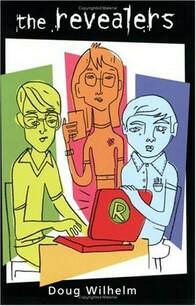

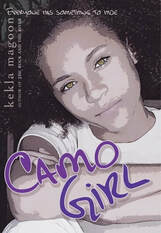
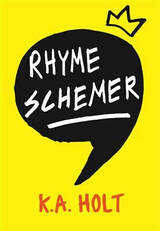









 RSS Feed
RSS Feed